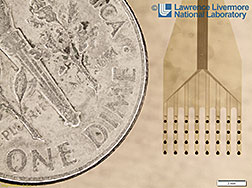- Number 424 |
- October 13, 2014
NIH taps Lab to develop sophisticated electrode array system to monitor brain activity

This image gives perspective on how tiny
the electrode arrays are when compared
to a dime. Graphics by Kwei Chu/LLNL
The National Institutes of Health (NIH) awarded DOE's Lawrence Livermore National Laboratory (LLNL) a grant recently to develop an electrode array system that will enable researchers to better understand how the brain works through unprecedented resolution and scale.
LLNL’s grant-funded project is part of NIH’s efforts to support President Obama’s BRAIN (Brain Research through Advancing Innovative Neurotechnologies) Initiative, a new research effort to revolutionize our understanding of the human mind and uncover ways to treat, prevent and cure brain disorders.
Lawrence Livermore is developing a neural measurement and manipulation system – an advanced electronics system to monitor and modulate neurons – that will be packed with more than 1,000 tiny electrodes embedded in different areas of the brain to record and stimulate neural circuitry. The goal is to develop a system that will allow scientists to simultaneously study how thousands of neuronal cells in various brain regions work together during complex tasks such as decision-making and learning.
This system will be the first of its kind to have large-scale network recording capabilities that are designed to continuously record neural activities for months to years.
The NIH project is a collaboration between LLNL’s Neural Technology Group; the laboratory of Loren Frank at UCSF; Intan Technology; and SpikeGadgets.[Ken Ma, 925.423.7602,
ma28@llnl.gov]
